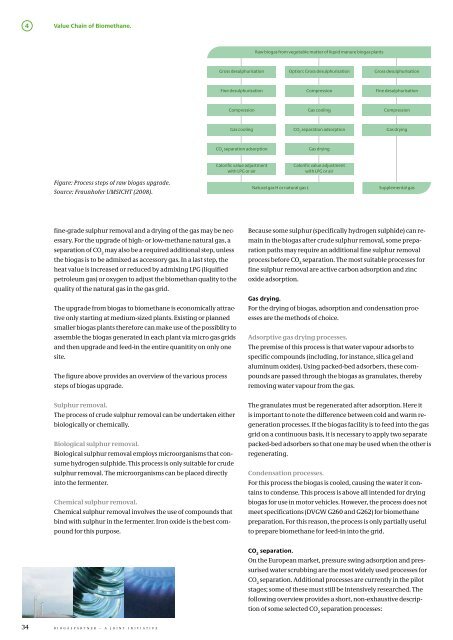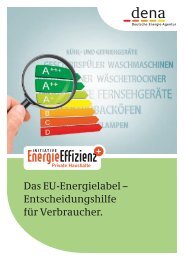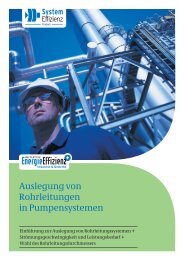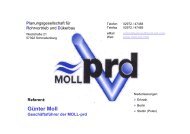biogaspartner – a joint initiative.
biogaspartner – a joint initiative.
biogaspartner – a joint initiative.
You also want an ePaper? Increase the reach of your titles
YUMPU automatically turns print PDFs into web optimized ePapers that Google loves.
Value.Chain.of.Biomethane.<br />
Figure: Process steps of raw biogas upgrade.<br />
Source: Fraunhofer UMSICHT (2008).<br />
fine-grade sulphur removal and a drying of the gas may be nec-<br />
essary. For the upgrade of high- or low-methane natural gas, a<br />
separation of Co may also be a required additional step, unless<br />
2<br />
the biogas is to be admixed as accessory gas. In a last step, the<br />
heat value is increased or reduced by admixing LPG (liquified<br />
petroleum gas) or oxygen to adjust the biomethan quality to the<br />
quality of the natural gas in the gas grid.<br />
The upgrade from biogas to biomethane is economically attrac-<br />
tive only starting at medium-sized plants. Existing or planned<br />
smaller biogas plants therefore can make use of the possiblity to<br />
assemble the biogas generated in each plant via micro gas grids<br />
and then upgrade and feed-in the entire quanitity on only one<br />
site.<br />
The figure above provides an overview of the various process<br />
steps of biogas upgrade.<br />
Sulphur removal.<br />
The process of crude sulphur removal can be undertaken either<br />
biologically or chemically.<br />
Biological sulphur removal.<br />
Biological sulphur removal employs microorganisms that consume<br />
hydrogen sulphide. This process is only suitable for crude<br />
sulphur removal. The microorganisms can be placed directly<br />
into the fermenter.<br />
Chemical sulphur removal.<br />
Chemical sulphur removal involves the use of compounds that<br />
bind with sulphur in the fermenter. Iron oxide is the best compound<br />
for this purpose.<br />
34 B I o G a s P a r T n E r <strong>–</strong> a j o I n T I n I T I a T I v E<br />
Raw biogas from vegetable matter of liquid manure biogas plants<br />
Gross desulphurisation Option: Gross desulphurisation Gross desulphurisation<br />
Fine desulphurisation<br />
Compression<br />
Gas cooling<br />
CO 2 separation adsorption<br />
Calorific value adjustment<br />
with LPG or air<br />
Natural gas H or natural gas L<br />
Compression Fine desulphurisation<br />
Gas cooling Compression<br />
CO 2 separation adsorption Gas drying<br />
Gas drying<br />
Calorific value adjustment<br />
with LPG or air<br />
Supplemental gas<br />
Because some sulphur (specifically hydrogen sulphide) can remain<br />
in the biogas after crude sulphur removal, some preparation<br />
paths may require an additional fine sulphur removal<br />
process before Co separation. The most suitable processes for<br />
2<br />
fine sulphur removal are active carbon adsorption and zinc<br />
oxide adsorption.<br />
Gas.drying..<br />
For the drying of biogas, adsorption and condensation processes<br />
are the methods of choice.<br />
Adsorptive gas drying processes.<br />
The premise of this process is that water vapour adsorbs to<br />
specific compounds (including, for instance, silica gel and<br />
aluminum oxides). Using packed-bed adsorbers, these com-<br />
pounds are passed through the biogas as granulates, thereby<br />
removing water vapour from the gas.<br />
The granulates must be regenerated after adsorption. Here it<br />
is important to note the difference between cold and warm regeneration<br />
processes. If the biogas facility is to feed into the gas<br />
grid on a continuous basis, it is necessary to apply two separate<br />
packed-bed adsorbers so that one may be used when the other is<br />
regenerating.<br />
Condensation processes.<br />
For this process the biogas is cooled, causing the water it contains<br />
to condense. This process is above all intended for drying<br />
biogas for use in motor vehicles. However, the process does not<br />
meet specifications (DvGW G260 and G262) for biomethane<br />
preparation. For this reason, the process is only partially useful<br />
to prepare biomethane for feed-in into the grid.<br />
CO .separation.<br />
2<br />
on the European market, pressure swing adsorption and pressurised<br />
water scrubbing are the most widely used processes for<br />
Co separation. additional processes are currently in the pilot<br />
2<br />
stages; some of these must still be intensively researched. The<br />
following overview provides a short, non-exhaustive description<br />
of some selected Co separation processes:<br />
2









